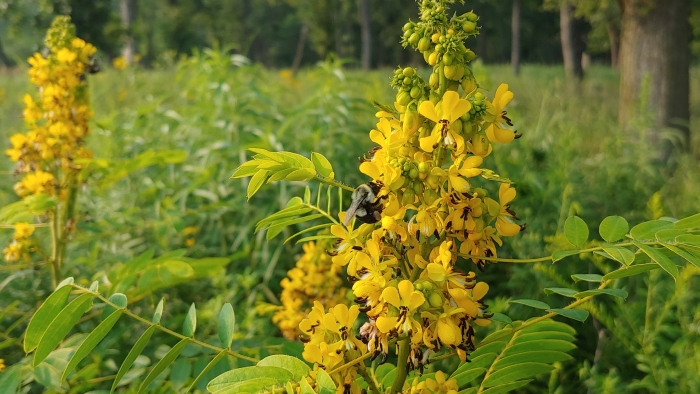American Senna
(Senna hebecarpa)
American Senna (Senna hebecarpa)
/
/

Ryan Sorrells
CC BY 4.0
Image By:
Ryan Sorrells
Recorded By:
Copyright:
CC BY 4.0
Copyright Notice:
Photo by: Ryan Sorrells | License Type: CC BY 4.0 | License URL: http://creativecommons.org/licenses/by/4.0/ | Rights Holder: Ryan Sorrells | Publisher: iNaturalist | Date Created: 2021-08-04T07:59:45-07:00 |

















































Estimated Native Range
Summary
Senna hebecarpa, commonly known as American senna or wild senna, is a perennial herb native to floodplain forests, moist meadows, and stream banks in eastern North America. It typically grows to a height of 3-6 feet (0.9-1.8 meters) with a similar spread. The plant features alternate, pinnately compound leaves and sparsely branched stems. From July to August, it produces clusters of showy, light yellow to orange flowers that are attractive to pollinators, especially native bumblebees. The flowers give way to long, flat seed pods that persist into winter, providing additional visual interest.
American senna is valued for its ornamental qualities, including its bright flowers and its ability to attract beneficial insects. It is used in perennial borders, wildflower gardens, and naturalized areas. It is also utilized in habitat restoration projects due to its adaptability to wet soils and its role in supporting wildlife. While it prefers part shade, it can tolerate full sun if sufficient moisture is available. It thrives in medium to wet soils with good drainage. Although generally low-maintenance, it can be susceptible to leaf spot diseases in humid conditions. Gardeners should be aware that while Senna hebecarpa is not typically invasive, it can self-seed in ideal growing conditions.CC BY-SA 4.0
American senna is valued for its ornamental qualities, including its bright flowers and its ability to attract beneficial insects. It is used in perennial borders, wildflower gardens, and naturalized areas. It is also utilized in habitat restoration projects due to its adaptability to wet soils and its role in supporting wildlife. While it prefers part shade, it can tolerate full sun if sufficient moisture is available. It thrives in medium to wet soils with good drainage. Although generally low-maintenance, it can be susceptible to leaf spot diseases in humid conditions. Gardeners should be aware that while Senna hebecarpa is not typically invasive, it can self-seed in ideal growing conditions.CC BY-SA 4.0
Plant Description
- Plant Type: Herb
- Height: 3-6 feet
- Width: 2-3 feet
- Growth Rate: Moderate
- Flower Color: Yellow
- Flowering Season: Summer
- Leaf Retention: Deciduous
Growth Requirements
- Sun: Part Shade, Full Shade
- Water: High
- Drainage: Medium
Common Uses
Bee Garden, Bird Garden, Butterfly Garden, Groundcover, Low Maintenance
Natural Habitat
Floodplain forests, moist meadows, and stream banks in eastern North America
Other Names
Common Names: Wild Senna, Casse Sauvage, Casse À Fruits Velus
Scientific Names: , Senna hebecarpa, Cassia hebecarpa, Cassia hebecarpa var. longipila, Senna hebecarpa var. longipila,
GBIF Accepted Name: Senna hebecarpa (Fernald) H.S.Irwin & Barneby